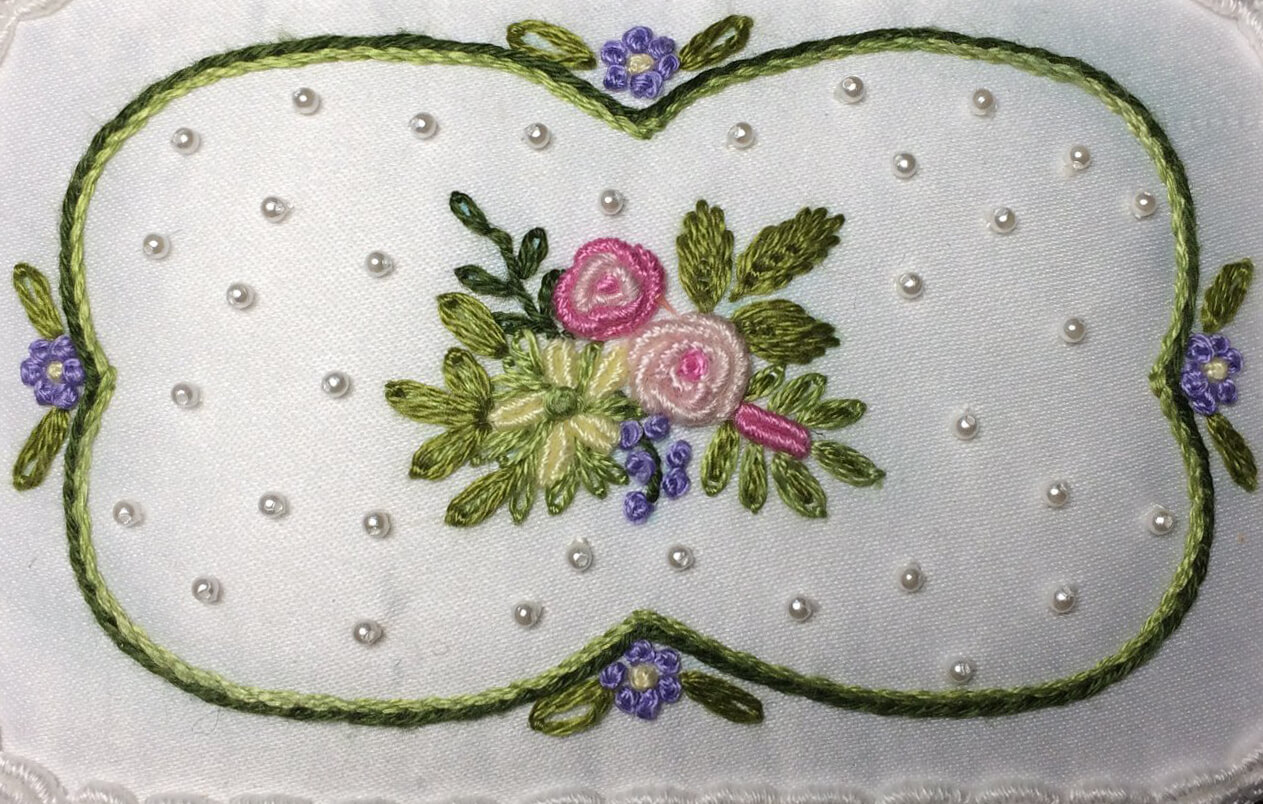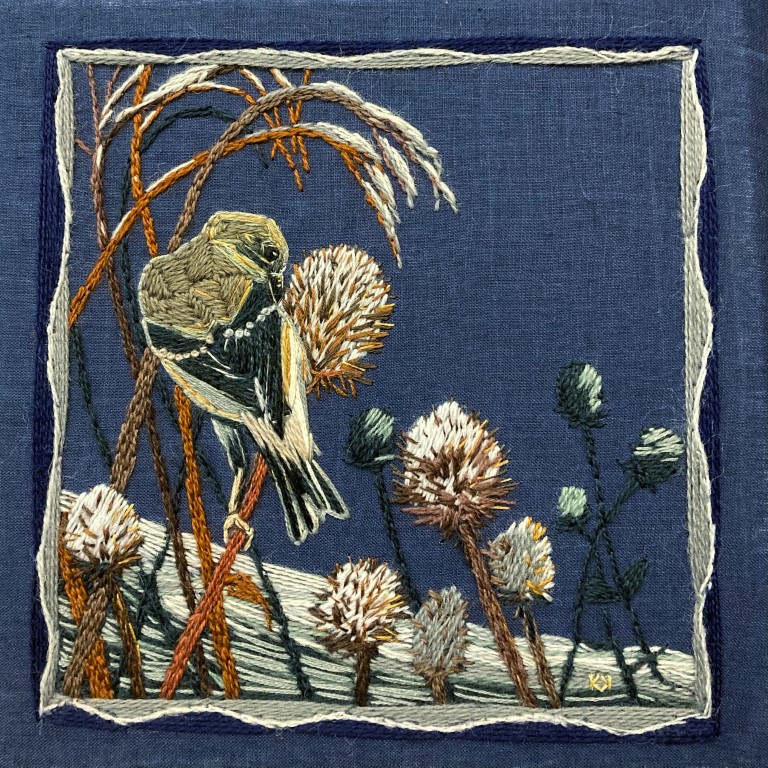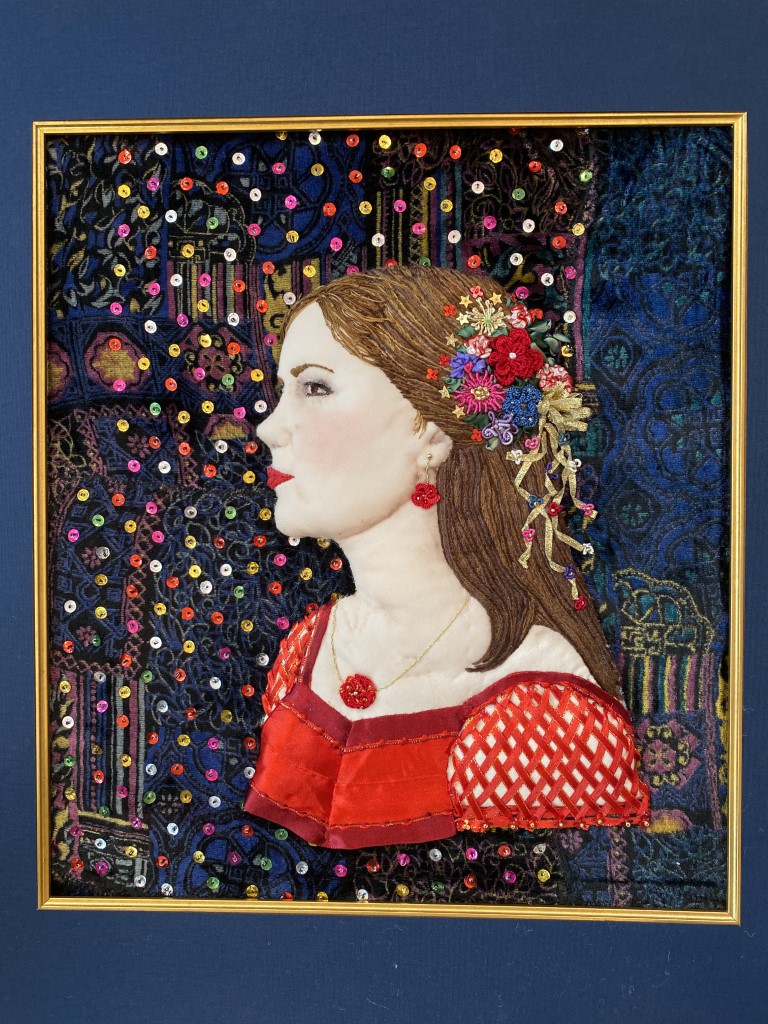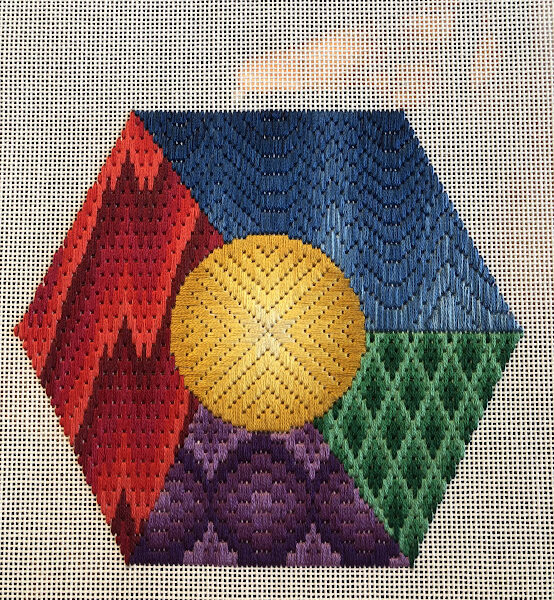Owen Davies
This profile of Owen Davies originally appeared in the September 2016 issue of Needle Arts magazine.
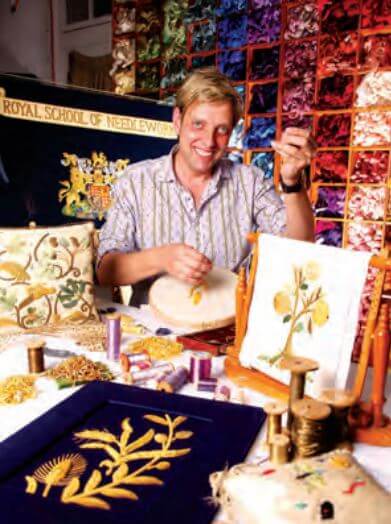
Owen Davies has the distinction of being the only man to complete the prestigious Apprenticeship at the Royal School of Needlework (RSN) since its founding in 1872. Enrolling in 1991 and graduating in 1994, he has spent the past twenty-five years creating and teaching embroidery and has published as well. More recently, Davies has been welcomed into the august Worshipful Company of Broderers, a group originating in the Early Modern period as the guild of professional embroiderers. It has evolved into the livery company supporting charities that foster the art of embroidery. Membership is a privilege, and the Trust relies on the financial support of members for its charitable work.
For all of his accomplishments, Davies had no plans that included a career in professional embroidery. “I came to the RSN really by chance,” he admitted. He had had a career as a chef and “a great deal of experience in the world” by the time he was twenty-one. Perhaps this experience helped him succeed as a man in a school that graduates mostly women.
Prior to enrolling at the RSN, Davies had dabbled in needlework. His mother did needlework and dressmaking. The summer he was seven, Davies’ grandmother taught him to stitch canvaswork to keep him quiet. The work did not please him, however, as the canvaswork was rather flat. It failed to provide him with the richness of meaning that surface embroidery would later offer him.
Davies’ first serious project was for the nursery of his niece, Lucy. Inspired by an alphabet in a magazine, he created a design with letters and motifs. He said, “I decided to satin stitch capital letters and insert a scene appropriate for each letter, such as apple for A and boat for B. My mother thought I would not finish and that she would have to pick it up and see it through.” Not only did Davies finish the project, he continued stitching items for the nursery and began stitching presents for friends.
Eventually, Davies landed an interview with Ann Butcher at the RSN. He was invited back for a second interview with Elizabeth Elvin and several other interviewers. “She found something in my work,” he said of Elvin. “She took a gamble on me, offering me one of the ten places available for that year.” Davies is grateful to Elvin for the opportunity to study. “The RSN provided amazing training for the next three years. Students followed a strict schedule. I produced some thirty-five projects in three years.” Davies was one of nine who finished and one of four offered a position as tutor upon completion of the Apprenticeship.

Davies is probably best known in the world of embroidery as co-author with Gill Holdsworth of Embroidered Knot Gardens: using three-dimensional stumpwork, canvas work, & ribbonwork in 2006. They note in their introduction, “At the beginning of the 21st century, faced with restlessness and uncertainty, the idea of a quiet and ordered garden in a safe, enclosed space is just as appealing to us as it was to our forebears during the tumultuous years of the seventeenth century.”
Embroidering knot gardens provided a vehicle not only for teaching embroidery, but expanding creativity and broadening horizons. For example, as part of his teacher training, Davies taught knot gardens to seven- and eightyear-old boys and girls two sessions a week for a whole term. “Barriers were broken down in this class,” Davies reported. All students flourished. “The boys really took to it,” he said. “They enjoyed the mathematics and mapping out the structure of the garden.”
In his work, Davies focuses on teaching. “Passing on the skills of embroidery is so important,” he asserted. “I am a custodian of these skills and work to find a way to enable students to achieve the level of skill they desire, to take it to whatever level they want.”

He teaches two days a week for the RSN Certification and Diploma Programmes and several times during the year at established venues in the United Kingdom. He also conducts ongoing private workshops with groups of students. He has taught in the United States and has begun to teach in Australia and New Zealand. He is open to travel for teaching.
In his workshops, Davies takes students on a slightly different journey than they would take in formal training. The workshop environment is multifaceted. “It’s not just about needlework,” Davies stated. “It’s about how needlework can be used to enable people to have a fulfilling life.” Davies helps students see the value of their work.
For Davies, another important component of an ongoing workshop is encouraging social interaction. He creates a safe environment where students can learn coping skills as well as skills in needlework. Oftentimes, the group solves problems other than those relating to needlework, thereby providing a lifeline for members.
“Students need encouragement throughout their journey and often need help in getting started,” Davies said. “The blank canvas can be overwhelming. I learned early on that figuring out where to start was daunting for many.” He provided a solution: stitching a knot garden could help students find a place to start. The stitching plane is broken up into areas that can be repeated. Students can start in one of these planes, making the whole seem more manageable.
Students discuss with Davies the work they would like to do. He helps them develop the idea while at the same time encouraging them to push boundaries. For example, one student constantly worked in needlepoint, but had expressed an interest in goldwork. He invited her to introduce some goldwork into her pieces. At first, she refused, saying that she couldn’t do it. With some work, he showed her how, adding various goldwork techniques when she was ready.
Davies encourages stitchers not to fret over making mistakes. “Embroidery has to be fun,” he said. He tells his students, “You have to make mistakes. You learn from them. None of that time is wasted; it’s valuable time.”
He recommends students keep a journal of their work. “They should jot down their initial thoughts and feelings,” Davies asserted. “These will be forgotten if they are not recorded.” If they are recorded, then students can go back and revisit what they have done. Contemporary and future generations of enthusiasts will be pleased to have this record accompanying the embroidery.
Furthermore, Davies promotes sampling and slowing down. “Students should sample. We want everything to be instant in this world,” he commented. “Taking time to sample allows students an opportunity for exploration.” The appearance of stitches can vary depending on texture and color of threads used. “In the same way, when stitching, we should take a step back and just be within
the moment, not just work toward completion. Each stitch should be savored,” Davies said. “The process of creation should be embraced and enjoyed. Stitchers need to focus on the stitch and its meaning and on the legacy of the stitch from the past.” Embroidery is more than the working of stitches; it is part of our heritage and connects us to it.

As evidenced in Embroidered Knot Gardens, Davies loves the work from the Elizabethan era. He favors the strong English tradition in his work, which is directly inspired by the flora and fauna as it appeared on needlework and in pattern books from the sixteenth and seventeenth centuries.
While the knot gardens for the book were sizable, Davies’ stated that his current work has tended “to get smaller and smaller. I like my work to evolve.” He reached down in his knapsack to produce a small glass box just 5˝ x 3˝ x 2.5˝. He opened the lid to reveal a miniature garden. He said, “It is portable so that one can display it anywhere and take it nearly everywhere as a visual
reminder of the beauty of the garden.”
Although small, the work is complex, as is evidenced in the color and shading. For one wall of the portable knot garden, Davies used 177 colors of floss, working six strands in the needle, each strand a different value of one color. Davies combines techniques, often changing them out from what was originally used in the pieces that inspire him. He combines crewelwork with goldwork and stumpwork; canvaswork with raised work and surface embroidery.
“I like for my work to talk to me,” he said. It constantly takes him in different directions and enriches his life. He encourages his students to embark on a similar voyage, take ownership of their work, and to embrace the art of embroidery.
Encouragement from Embroidered Knot Gardens
“Remember—be brave—experiment!”
“Have confidence to do things differently.”
“Remember that you can find potential design shapes anywhere you look and inspiration often strikes when you least expect it.”
“Your design does not have to be very complicated—a simple image can be very effective and satisfying.”
“Do not be afraid of making mistakes—sometimes they can enhance your work in unexpected ways.”
“Most of all, have fun!”
To learn more about Owen, visit his website www.owendaviesstitch.com.
Profile by Cheryl Christian, Needle Arts Editor
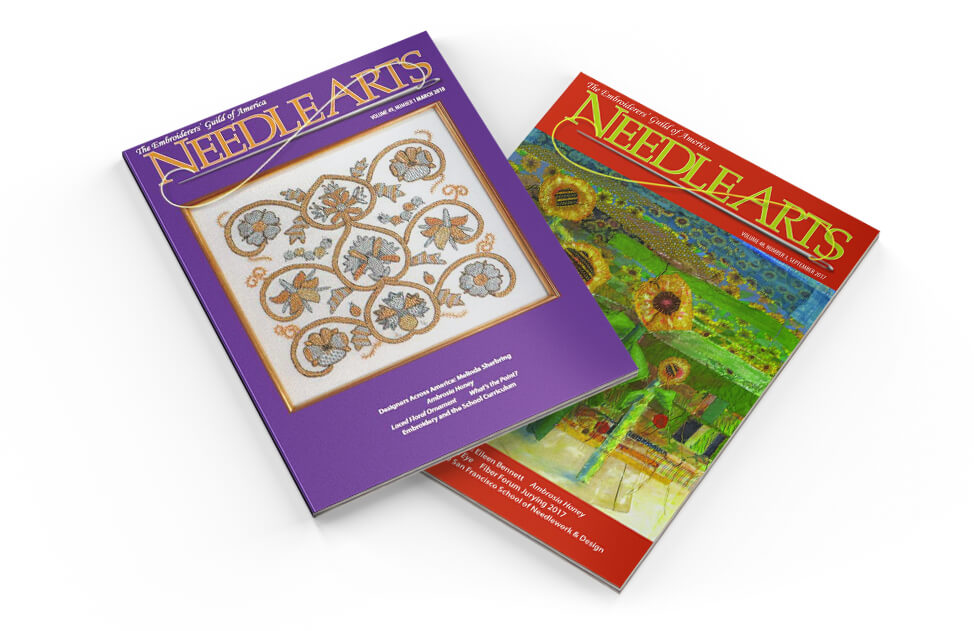
Needle Arts Magazine
Our quarterly magazine is one of the benefits of being an EGA member, come join us on the link below. Past issues of Needle Arts are available for purchase.
